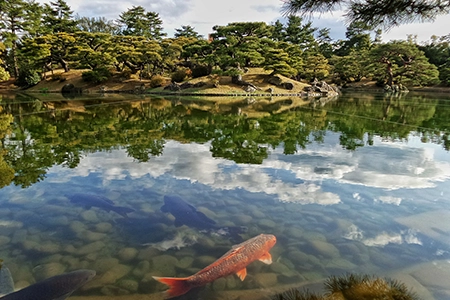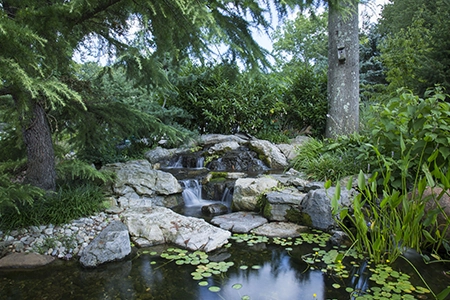Introduction
Fish ponds have long been cherished as tranquil additions to gardens, providing both aesthetic beauty and a peaceful retreat for homeowners. Whether you dream of a small, intimate water feature or a grand, elaborate pond, understanding the various styles, benefits, and potential drawbacks is essential to creating your ideal aquatic oasis.
We’ll explore the different styles of fish ponds, highlighting their unique characteristics and design elements. We’ll also delve into the benefits and potential challenges of having a fish pond, helping you make an informed decision about incorporating one into your garden.
Finally, we’ll provide a step-by-step guide to building a simple fish pond, ensuring you have all the knowledge you need to embark on this rewarding project.
What is a Fish Pond?
A fish pond is a type of garden water feature designed specifically to house fish, such as koi, goldfish, or other ornamental species. These ponds are meticulously planned to create a safe and healthy environment for their aquatic inhabitants.
Key aspects of a fish pond include maintaining clean and well-oxygenated water, which is often achieved through the use of filtration systems, pumps, and aeration devices. To ensure the well-being of the fish, these ponds typically incorporate various habitats and hiding spots, such as underwater plants, rocks, and specially designed shelters.
Popular Styles of Fish Ponds
- Koi pond
- Goldfish pond
- Ornamental fish pond
- In-Built fish pond
- Raised fish pond
Koi Pond
Specifically designed for keeping koi fish, which are larger and more robust than many other ornamental fish. These ponds typically feature deep water, often at least three to six-feet, to provide sufficient space for the koi to swim and grow. Koi ponds require sophisticated filtration systems to maintain high water quality and prevent the build-up of harmful toxins, as koi produce a significant amount of waste. Decorative elements like rocks, waterfalls, and bridges are often used to enhance the visual appeal of these garden water features while providing shade and protection for the fish.
Goldfish Pond
Goldfish ponds are similar to koi ponds but are typically smaller, shallower and are designed to accommodate small fish species. These ponds generally require less intensive filtration systems due to the smaller size and lower waste production of goldfish compared to koi.
Goldfish ponds can include a mix of aquatic plants, as goldfish are less likely to damage vegetation extensively. These plants not only enhance the beauty of the pond but also provide natural filtration and oxygenation.
Ornamental Fish Pond
Combine elements of natural ponds with features tailored to fish keeping, creating a balanced and visually appealing garden water feature. These ponds include aeration devices and submerged plants to create a healthy environment for the fish.
The submerged plants provide hiding spots and breeding grounds for the fish, while also contributing to water quality by absorbing nutrients and providing oxygen. Ornamental fish ponds often incorporate decorative features such as fountains, waterfalls, and rock formations, blending the aesthetics of a natural pond with the practical needs of fish care.
Built-in Fish Pond
A built-in fish pond is a carefully designed aquatic feature that seamlessly integrates into the landscape of your garden. Unlike prefabricated ponds, which are typically above ground and made from plastic or fiberglass, in-built ponds are custom-built and often dug into the ground, decking or even a particularly large garden wall lined with natural or synthetic materials, and adorned with a variety of plants and decorative elements. This option can prove to be an expensive route to go if you’re looking to introduce aquatic life into your garden.
Raised Fish Pond
This type of pond, particularly those constructed with either wood or brick, offer a unique and elegant way to incorporate aquatic species into your garden. These ponds are built above ground, making them accessible and visually striking additions to any outdoor space. With the right design and materials, a raised fish pond can provide a beautiful and practical habitat for fish while enhancing the overall landscape of your garden.
Benefits of Having a Fish Pond
- They add to your garden’s visual Appeal
- Fish ponds create a relaxing environment
- The present educational benefits concerning wildlife and water systems
Drawbacks of Having a Fish Pond
- They can be high maintenance
- Fish ponds can prove costly to ensue they are well-balanced and stocked
- Predators can seek to invade your pond and prey on your fish
How to Build a Fish Pond
Plan and Design Your Pond
When designing your pond, choose a spot that receives partial sunlight. Too much direct sunlight can overheat the water, while too little can inhibit plant growth. Decide on the size and shape of your pond. A simple, round or kidney-shaped design is easiest for beginners.
Mark the Pond Outline
Use a rope, garden hose, or spray paint to outline the shape of your pond on the ground.
Excavate the Pond Area
Start digging within your marked outline. Aim for a depth of at least 18-24 inches for small ponds, and 3 feet or more for larger ponds that will house bigger fish like koi. Create shelves or ledges for planting aquatic plants. These shelves should be about 12 inches deep and 12 inches wide.
Prepare the Base
Remove the debris, any sharp rocks or roots that could puncture the liner. Lay down a protective underlayment to cushion the pond liner. This could be a commercial underlayment material or something like old carpet or newspaper.
Install the Pond Liner
Spread the pond liner over the hole, ensuring it covers all surfaces with some overlap around the edges. Smooth out any wrinkles and press the liner into the contours of the hole, especially along the shelves.
Secure the Liner and Fill the Pond
Place rocks or stones around the edge of the pond to hold the liner in place and create a natural look. Begin filling the pond with water, gradually smoothing out the liner and adjusting the edges as needed.
Install the Pump and Filtration System
Follow the manufacturer’s instructions to install the pump and filter. Place the pump at the deepest part of the pond and ensure the filter is positioned to allow easy access for maintenance. You can also add a pond skimmer too in order to help clear debris from the surface.
Add Plants and Decorations
Introduce plants such as water lilies, marginal plants, and oxygenators to help balance the ecosystem and provide shelter for fish. Next, place gravel at the bottom of the pond and arrange rocks around the edges and shelves for a natural appearance.
Cycle the Pond Water
Allow the pond to cycle for at least a week before adding fish. Use a water testing kit to ensure the water parameters (pH, ammonia, nitrites, and nitrates) are safe for fish.
Introduce Fish
Finally, the best part! Once the water conditions are stable, gradually introduce your fish to their new habitat. Start with a few fish and monitor the water quality regularly.
Why Choose NGS
Creating a beautiful and functional pond in your garden can be a complex and time-consuming project. Fortunately, Norfolk Garden Services specialises in transforming your aquatic dreams into reality. With a team of experienced professionals and a passion for landscape design, Norfolk Garden Services offers comprehensive solutions to help you build the perfect pond that complements your garden’s aesthetics and meets your unique needs.
We will begin with an in-depth consultation to understand your vision, preferences, and budget, offering expert advice on pond styles, materials, and additional features to enhance your garden. Our skilled team handles the precise excavation process, ensuring the pond’s shape and depth meet your specifications, and uses high-quality materials for lining and construction to ensure durability and longevity.
We can provide reliable, high-quality pumps, filters, and aeration systems to maintain clean and healthy water, and set up optional features like skimmers, waterfalls, and fountains to enhance functionality and aesthetic appeal. Specialising in aqua scaping, we carefully select and plant aquatic vegetation to support a balanced ecosystem, and meticulously place decorative elements such as rocks, gravel, and edging to achieve a natural look.
To find out more about how we can help you build your very own fish pond, head to our homepage and click the ‘Make an Enquiry’ option!
Further Reading
Inspired by our fishy tales and want to learn more? Here are some more articles that may interest you:
Revitalise your Pond – Best Oxygenating Plants for Clearer Waters
Water Management 101: Vital Role of Garden Drainage Solutions
Best Sensory Garden Plants: Enrich your Outdoor Experience
Vast to Vibrant: Big Garden Ideas for Every Season













